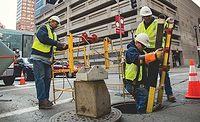Sporting events themselves might just be a game, but the security technology, procedures and policies in and around stadiums and other venues can be a matter of life and death.
Violent extremists and potential civil unrest top of the list of concerns for stadium security professionals, says Lou Marciani, director of the National Center for Spectator Sports Safety and Security (NCS4), who cites baseball stadiums’ adoption of megatometers to search backpacks and bags, and the “clear bag” policy of the National Football League, as examples of the resulting policy changes.
“We’re concerned more so than ever since 9/11 about the type of person coming to a game, and potentially what incidents could occur, by watching who’s coming in, first by the gate itself,” Marciani says. “There’re more behavioral analysis being done and training being done, where they’re observing people and getting a feel for where there’s potentially an issue.”
Active shooters and explosives – whether vehicle-borne, suicide bomber or remote – are increasingly on stadium security directors’ minds, Marciani says. “They’re looking more at the barriers, and moving the perimeters away from the venues,” he says. “There’s a lot more reliance on information sharing. The federal government and states are communication threat information to local authorities in ways that have really improved, which is a major way of deterring incidents.”
NCS4, based at the University of Southern Mississippi, urges stadium security personnel to be trained annually on incident management, risk and evaluation, which the organization delivers about 60 times per year around the country, Marciani says. “If you don’t train and exercise, it’s difficult to be responsible for those major gatherings of people,” he says.
Baylor Builds from Scratch
When Baylor University decided to build a new football stadium for the Baylor Bears, security personnel had the opportunity to think through their needs, procedures and infrastructure from scratch.
“At least, that’s how they sold it to us,” chuckles Bob Hartland, associate vice president for information technology infrastructure, regarding McLane Stadium, which opened in fall 2014. More seriously, he adds, “Building from scratch is very unique. It had its advantages in terms of making sure we had the infrastructure in place. Obviously, with the world we live in now, any place you have a large congregation of people has its concerns.”
The security operation at McLane had a trial by fire at Baylor’s first game in 2014, when former President George W. Bush flipped the coin at the outset, says Jon Allen, assistant vice president and chief information security officer. “And oh yeah, we’re going to have the Secret Service, the FBI, governors and senators. I can’t even remember the list. It was a ‘who’s who’ among Texas officials,” Allen says with a laugh. “And this was the first time we were running all this stuff. It was tenuous. We were all nervous.”
Baylor had moved from a 65-year-old bowl-shaped facility to a more tiered stadium built only for football, with a relatively modest total seating capacity of 45,000 to 47,000, Hartland says, adding that the size gives the university the option to expand. “It’s probably on the smaller side than most,” he says. “That was by design.”
McLane is walking distance from campus and right alongside both a river and a highway, all of which presents challenges and concerns. This required ensuring that “we had the proper camera systems, to be able to monitor and adjust,” as well as coordination with government agencies responsible for those outside pieces of the facility, Allen says.
A major upgrade from the former Floyd Casey Stadium has been the event operations center, which had been housed in a 10-foot by 14-foot trailer near the north end zone. The new venue has a full operation event center with screens that monitor infrastructure like lighting systems and escalators, Allen says, allowing physical and information security to more seamlessly merge. That center is “hopping at the start of the game and the end of the game,” he says. “Getting that mass of humanity in and out is critical.”
“The cool part is being able to get information to the folks who need it – the cameras, weather-related information, radio systems within the venue – so that people can take action,” Allen adds. “It was a struggle in the old venue. You couldn’t have people in the trailer, let alone provide them the information they needed to take action. Now, it’s the sky’s the limit. What are the next pieces of information that would be helpful for people?”
Related to moving the “mass of humanity” is the new stadium’s gate geography, which has been slimmed down from 16 entrances at Floyd Casey to five at McLane, Hartland says. “That was significant,” he says. “I’m not sure if it was built that way for security or architecture, but it really helped with the flow of the fans.”
State-of-the-art ticket scanning machines also have helped ensure that fake tickets aren’t used to get into the venue, Allen says. “That’s not just a fraud issue,” he says. “But if there’s a sign that people are using fake tickets to get into your venue, that’s a security issue.” Baylor also adopted a “no re-entry” policy at the new venue to help bolster physical security, he adds.
Security staff also needed to think through the expectations of both fans and personnel themselves in terms of access to information systems and Wi-Fi, and balance access and security, Allen says. “The expectation of end users has changed dramatically as a result of the consumerization of information technology,” he says. “They want to be able to use an iPad app to change a critical internal system. You have to weigh the business need with the risk. It raises the bar significantly.”
Among the internal systems so impacted is a large decorative fountain, which has a Wi-Fi iPad app to adjust lighting. “Now, the fountain in the middle of my facility is a potential entrance point for somebody,” Allen says.
Bottom line, during the Baylor Bears’ first season in McLane Stadium, security personnel did not become aware of any major mischievous threats, Allen says. Local law enforcement seemed quite impressed by the power of information they had at their fingertips, he says, such as the range of areas they could monitor via the camera system, or the ability to get up-to-the-minute weather information during lighting storms. “In the old venue, it was a nightmare situation – you couldn’t easily monitor what was going on,” he says.
‘Situational Awareness’ in Miami
In the three and a half years since the Miami Marlins opened their new stadium, Marlins Park, they have averted at least one potential nightmare situation. Earlier this season, the FBI arrested a “potential homegrown ISIS-inspired individual” who lived a half-mile away and had talked about sneaking a rifle into the stadium, says Greg Terp, director of security with the team and a 35-year Miami-Dade police veteran who has staffed numerous sporting events, including five Super Bowls.
“Once that [situation] broke, having the ability to contact the FBI and local law enforcement was important to us,” Terp says. “They went through to vet the system and tell us if anybody else was involved. Do they work with anyone in concessions?” he says. “You need a good relationship with law enforcement and the FBI to get information quickly and change your posture.”
To make sure they don’t fall victim to an inside job, teams and stadiums need to vet not only their fans but also employees, Terp says. “Al Qaeda groups have gotten employees to work at airports,” he says. “We’ve worked on screening our employees.” And they have thought through credentialing procedures to make sure security knows who gets in where, and how. “Certain areas, certain times, we want to be sure that people who come into these [restricted] areas are supposed to be there,” he says. “Some of the stuff we’ve done with handprints and fingerprints is huge. That tells you right away.”
Marlins Park security focuses more than anything on incident management and situational awareness, Terp says. That includes “understanding what the threats are, what are the threat protocols, an all-hazards type of thing – terrorism, anything weather-related, building collapse,” he says. “It’s so that everybody is on the same page and we make sure we are sharing information with law enforcement, operations and event security.”
The security operation is continuously examining and working to improve its credentialing, security systems and video systems, for example, by attempting to increase the focus on camera zooms to better monitor fan ruckuses that sometimes break out over foul balls. “So we can go back, zoom in and see who started the fight,” Terp says. “We’ll know exactly what occurred and can identify the people involved.”
At the perimeter of the stadium, the 37,000-seat Marlins Park has followed the urgings of Major League Baseball in installing metal detectors as part of a $400 million stadium renovation, which needed to be retrofit. “Our gates weren’t designed for metal detectors,” Terp says. “We had to look at, how are we going to set this up” in a way that didn’t create huge lines. “Field testing was huge, so we can actually see what’s occurring and see the value of the efficiency.”
Ultimately, the stadium went with a system from Rapiscan that provided the ability for remote adjustments and was slightly cheaper than some others. The team has since made adjustments to queueing lines to make them move more quickly and ensure that fans don’t get upset. But Terp believes that sports fans are increasingly amenable to the need for security procedures. “They don’t want it overdone, but they want it done,” he says. “They don’t want too much inconvenience.”
Marciani of NCS4 agrees. “This is almost like at airports,” he says. “At first, you and I didn’t want to go through it, but now it’s just another day. People appreciate being at an event, especially with a large magnitude of 100,000 people, and they respect that. They want a safe flight; they want a safe game. They’re bringing their families. They want a seamless experience. We’re trying to balance that fan experience with safety and security.”
The “See Something, Say Something” campaign of the Department of Homeland Security – which manifests at stadiums with the ability for fans to report potential incidents or suspicious persons by text – has helped change mindsets, Marciani believes. “People are becoming first responders,” he says. “That’s a big change to help us.”
NCS4 Offers Trainings, Certification, Assessment
The National Center for Sports Stadium Safety and Security (NCS4) at the University of Southern Mississippi offers risk management and evacuation trainings for high school, college and professional sports as well as marathons through a partnership with the Federal Emergency Management Agency (FEMA) and the Texas A&M Engineering Extension Service (TEEX).
One end result of those trainings can be that NCS4 dubs those so educated as certified sports security professionals, says Lou Marciani, director of the center. “That’s to raise standards in the industry, so that leaders have good qualifications and we raise the bar,” he says. “We have a good programs to certify people on the line – ticket takers, ushers, concession people. Who are these people? We provide background checks and module-based training.”
NCS4 also travels to stadiums and performs assessments of their security procedures through a program called Sport Event Secure Aware, Marciani says. “That’s important because a third party should assess risk, as well as training and exercises,” he says. “We help them plan and be better at what they do.”




